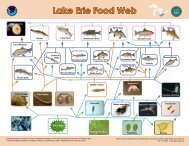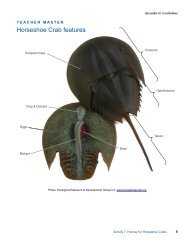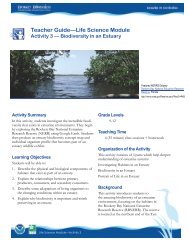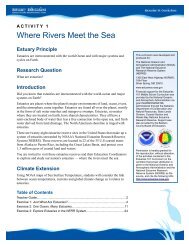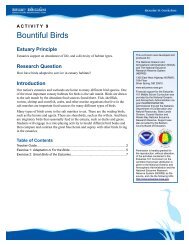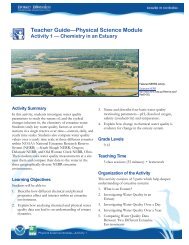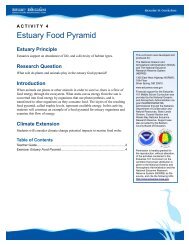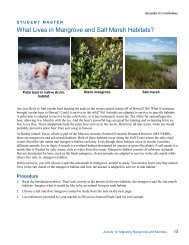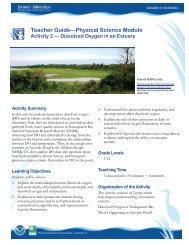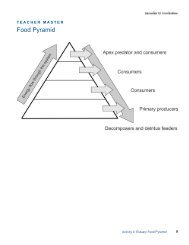Teacher GuideâEarth Science Module - Estuaries NOAA
Teacher GuideâEarth Science Module - Estuaries NOAA
Teacher GuideâEarth Science Module - Estuaries NOAA
You also want an ePaper? Increase the reach of your titles
YUMPU automatically turns print PDFs into web optimized ePapers that Google loves.
Part 3 — Interaction of Tides and River Flow3a. At the mouth of the river (lower right), what are the highest and lowest salinity levels, in ppt, during this timeframe?Answer: High 22, low 20 ppt (approximately)3b. Now look up river at the upper left of the animation. What are the highest and lowest salinity levels there?Answer: High 13, low 6 ppt (approximately)3c. Why is there such a difference between these two locations?Answer: Fresh water enters up river, salt water enters from Chesapeake Bay.3d. Play the animation and study the full extent of the river. How often do the arrows change direction? How doesthat affect salinity throughout the river?Answer: The arrows flow up (as the tide rises) for about 6 hours, then down (as the tide falls) for 6 hours. As tide rises, salinityincreases and works it way up river, then vice-versa as tide falls.3e. At what point are there greatest changes in salinity throughout the day? Why do you think so?Answer: Saltier water moves up the river at high tide and fresher water moves seaward at low tide. Water with salinity of about22 ppt moves from the mouth of the river to beyond Point 1 when the tide comes in. The area from Point 1 to Point 3 ranges fromabout 22 to 12 ppt. The area from Point 3 upriver ranges from about 16 to below 5 ppt.3f. Does the freshest water (the darkest blue) ever appear on the image? Where and for how long? Does the saltiestwater (red) ever appear on the image? Where and for how long?Answer: The freshest water (less than 5 ppt) appears in the upper-most part of the river about every six hours when the arrowsare moving seaward. Water of 25 ppt does not seem to appear on the map. The saltiest water is about 22 ppt and appears in thelower right-hand corner of the map. It does not go upriver much past station 1.3g. How does the water get mixed from top to bottom as the salinity changes from upstream to downstream?Answer: The water seems to get most thoroughly mixed from top to bottom in the area that is farthest upstream and especiallywhere the river is shallow. The salinity in the areas most seaward, and especially the deeper parts of the river, does not change muchat all.Earth <strong>Science</strong> <strong>Module</strong>—Activity 27



